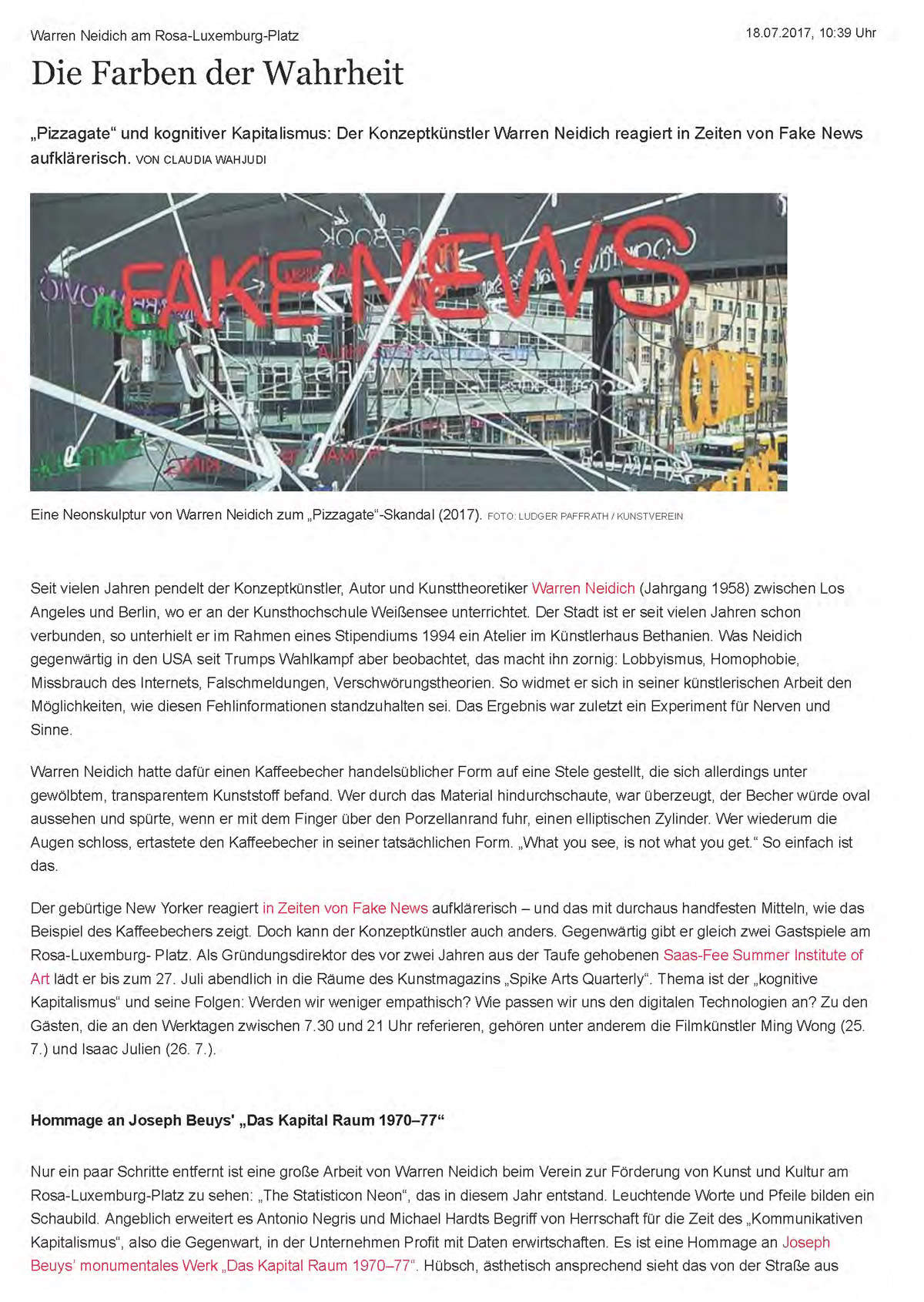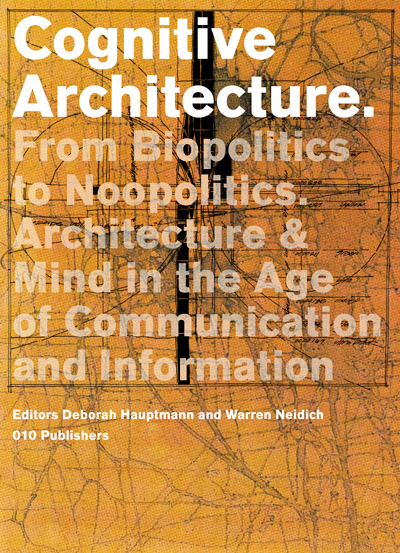Specters of the Acephalous (2020)
Specters of the Acephalous (2020)
Something Between Us at KAI10 | Arthena Foundation
Exhibition: March 6 to August 2, 2020
Curators: Ludwig Seyfarth and Harriet Zilch
Pizzagate: From Rumor to Delusion
Pizzagate: From Rumor to Delusion (2019)
Video, 19:19
“Pizzagate: From Rumor to Delusion” is an experimental documentary that describes our post-truth society through the Pizzagate fake news story. The Pizzagate scandal was a conspiracy theory that went viral in which Hillary Clinton and her associates at her campaign offices were accused of running a child sex ring out of the Comet Ping Pong pizza parlor in Washington D.C. It also uncovers the reasons for the madness that motivated Edgar Welch to drive up from North Carolina to free these girls.
password: hello
On Cognitive Capitalism
Interview by Hans Ulrich Obrist
Rumor to Delusion
May 5 – November 24, 2019
Zuecca Project Space
La Biennale di Venezia, Italy
Scoring the Tweets
Rumor to Delusion
9.05.2019 – Opening performance
Zuecca Project Space
La Biennale di Venezia, Italy
Pizzagate: From Rumor to Delusion
Video, 19:19
"Pizzagate: From Rumor to Delusion" is an experimental documentary that describes our post-truth society through the Pizzagate fake news story.
Show Me Your Selfie, Aram Art Gallery, Seoul, Korea
Show Me Your Selfie
Aram Art Gallery, Seoul, Korea
Exhibition 7/17-10/6
Interview Artpulse magazine, Paul Laster
Interview Artpulse magazine
Paul Laster
An American post-conceptual artist, writer and theorist, who splits his time between Los Angeles and Berlin, Warren Neidich has been exploring scientific and philosophical ideas in his art for the past 30 years.
Conversation with Noise, 2018
[su_vimeo url="https://vimeo.com/287072895" width="1600"]
[su_spacer size="40"]
[su_vimeo url="https://vimeo.com/297594486" width="1600"]
[su_spacer size="40"]
PRISKA PASQUER
Cologne, Germany
www.priskapasquer.art
'This Is Not a Selfie’ tackles the interesting history of self-portraits
'This Is Not a Selfie' tackles the interesting history of self-portraits
September 10, 2018 by Joanne Milani, Times Correspondent
“Warren Neidich has carried on his own guerilla war with history in his 1993 “Unknown Artist” series. He added his own face to group photos of famous artists of the past. As the “unknown artist,” he appears next to a young Salvador Dalí in one group photograph. He is next to a leather-jacketed Andy Warhol in another. By doctoring the original photos, he declared “an assault on a truly verifiable record,” i.e. the documentary photograph.
Neidich wasn’t the first artist to have fun with doctored identities. In 1927, T. Lux Feininger did a poetic take on stolen identity when he disguised himself as Charlie Chaplin, complete with mustache. You can see “The Little Tramp” in Feininger’s photograph. It’s a hazy face glancing at you through the frame of a picture or mirror. That’s Feininger’s way of telling you that this image is a fantasy.” – Joanne Milani
Böser Blick in unser Hirn (A dirty look into our brains)

A dirty look into our brains
Profound art by Warren Neidich at Priska Pasquer Gallery
They call it a ‘Trump Cup’. It’s a coffee mug, the rim of which we’re invited to touch. Like any other mug, it is perfectly circular. However, if look at it from where we stand (that is, through a glass panel installed above the object), the mug’s rim appears to be oval. Which are we to trust, thus, our hand or our eyes? With the object described above, Warren Neidich finds a pithy allegory for the today’s phenomenon of ‘fake news’.
On view at Priska Pasquer gallery there is yet another composition which elaborates on the same problem more explicitly. “Pizzagate” is the title of a spherical accumulation of words and arrows crafted in colourful neon tubes. This could be a representation of the brain, just as well as it could be a materialization of a digital cloud.
“Pizzagate” refers to a smear campaign, which damaged Hillary Clinton’s image decisively during the 2016 US presidential campaign. Trump’s campaign team claimed that a paedophile ring operated out the basement of a pizza parlour in which Clinton liked to dine. Agitated by the news, an armed man finally broke into the restaurant and started shooting around wildly. As it turned out, though, there weren’t any paedophiles, nor did the pizza parlour have a basement.
Warren Neidich, professor at art academies in the US and in Berlin, is a trained neurologist and advocates a theory, according to which fake news enter into and leave traces in our brains – even if we know them to be absurd and made up. Neidich’s latest exhibition in Cologne is titled “Neuromacht”.
The artist believes our thoughts to have the power to change – that is, if we are ready to explore terrains outside our habitual streams of consciousness, which is where our potentials for creativity reside. To connect information in unexpected ways means to think against the grain of dominant consumption oriented thought patterns.
The 60-year-old artist provides concrete examples in his work “Noise and the Possibility of a Future”, which is also the subtitle of his show. He smashes loud speakers, puts their pieces back together, and accompanies his newly collaged sculptures with the soundscapes of their destruction. In this way, he liberates the object from its common use and allows it to become something new.
And there is a good sense of humour, too, in each and every one of Neidich’s installations. The artist’s “Wrong Rainbow Paintings” are colour circles, the black centres of which resemble the iris of a human eye. The artist has also taken an interest in the rainbows depicted in historical landscape paintings – their colour scales being oddly unrealistic. As we watch Warren Neidich extract the colours of a Caspar David Friedrich rainbow, we may ask ourselves why the ‘wrong’ representation manages to capture our emotional truth much more accurately than any cold realism ever could. Prices between 25.000 and 120.000 Euro.
Translation: Katharina Weinstock

How noise and neons give birth to new worldviews
Mit Noise und Neon zur neuen Weltsicht
(How noise and neons give birth to new worldviews)
July 24, 2018 by Nelly Gawellek
How noise and neons give birth to new worldviews
Warren Neidich’s introduction into ‘Neuro-Aesthetics’ at Priska Pasquer
Fake news, alternative facts and record-breaking headlines. The recent US presidential campaign, and relentlessly twittering president Donald Trump, give us an idea how closely political developments are actually linked to their media presentation. One of the most unsettling revelations: the Internet, its news and communications channels, don’t distinguish between ‘felt truth’ and ‘real facts’. »Pizzagate«, an entirely made-up scandal, which is considered to have sealed Hillary Clinton’s defeat, provides the title for Warren Neidich’s central installation within his solo show at Priska Pasquer gallery. A »Cloud« of neons, spreading out in the gallery space connects names, events and buzzwords around a conspiracy theory, which ended up deciding the presidential election. Algorithmically created pseudo-connections – glowing seductively – merge into a robust construct – one, which after all ended up having a long-term impact on our everyday realities.
Working interdisciplinary, artist, writer and theorist Warren Neidich zooms in on the neuronal conditions, which make up for our perceptions of reality. Based on the assumption that our brains is plastic matter that can be sculpted, and that each information feeds into its structure, continually shaping and transforming it, Neidich strives to unlock visual art’s potential to break down ingrained thought patterns in order to enable new ways of thinking. Noise music, the dissonant sounds and unusual rhythms of which go against the grain of our listening habits, is but one example for such processes of mental reformatting. For his piece »Scoring the Tweet(s)« (2017), the artist developed a composition of his own, in which he translated 195 tweets by Donald Trump into a musical score.
Neidich calls his field of research »neuro-aesthetics«, fusing various disciplines and intellectual traditions: Surrealist and dadaist deconstruction meets futurist techno-utopianism; German romantic philosophy’s musings about chaos meet scientific findings about our sense of vision. In ways, which are intuitive, and at times almost playful, Neidich ties these threads together with discourses on the digital era. Taking a institutional stance, Warren Neidich’s solo show provides an introduction into the depth and breadth of its research. The show’s extended duration and rich event program promise to actively speak to the public.
Text: Nelly Gawellek
Translation: Katharina Weinstock
Scoring the Tweets
Scoring the Tweet(s) (2018)
In his improvisational performative work Scoring the Tweet(s)(2018), Warren Neidich uses a cut and paste method first devised in Surrealism and later in the works of William Burroughs, to alter and rearrange the one hundred and ninety-six tweets of Donald Trump that mention fake news to create a graphic score. This score was installed for its performance at PRISKA PASQUER in the evening of May 12, 2018.
Scoring the Tweet(s), 2018, is an installation composed of 16 graphic scores that are displayed and stretched across four pairs of microphone stands and a video projection created during its performance. The graphic scores were created by cutting up 196 tweets of Donald Trump which concern Fake News and assembling them as poems upon music composition paper which is photocopied on translucent velum and then cut into strips before being assembled. The musicians are instructed to visit each score at designated times and perform it. The work expresses the power of poetry and improvisation as forms of political resistance.
GERMAN:
In seiner performativen Arbeit Scoring the Tweet(s) (2018) verändert und re-arrangiert Neidich 196 Tweets von Donald Trump, die Fake News thematisieren. Mit Hilfe einer Cut-and-Paste-Methode gestaltet er eine musikalische Notation. Diese Methode illustriert die Unbestimmtheit der Sprache wie auch ihre tieferliegende Pluripotentialität. Sie wurde ursprünglich im Surrealismus entwickelt und später auch in den Arbeiten von William Burroughs eingesetzt. “Scoring the Tweet(s)” wurde für seine musikalische Premiere bei PRISKA PASQUER erstmalig aufgebaut und am Abend des 12. Mai 2018 aufgeführt.
Scoring the Tweet(s), 2018, ist eine Installation, die aus 16 grafischen Partituren besteht, welche über vier Paare von Mikrophonständern gespannt sind. Dazu gehört eine Videoprojektion, die während der Aufführung entstand. Für die Partituren wurden 196 Twitter Nachrichten von Donald Trump, die den Begriff Fake News enthalten, in Fragmente zerschnitten und als Gedichte auf transparentes Papier collagiert, auf das auch Notenlinien kopiert wurden, bevor es, in Streifen geschnitten, aufgehängt wurde.Die Musiker wurden instruiert, nach einem vereinbarten Ablaufplan zu jeder Partitur zu gehen und sie auszuführen. Diese Arbeit vermittelt die Macht von Poesie und Improvisation als Form von politischem Widerstand aus.
PRISKA PASQUER (Köln, DE)
Scoring the Tweets
Rumor to Delusion
9.05.2019 – Opening performance
Zuecca Project Space
La Biennale di Venezia, Italy
Scoring the Tweets
12.05.2018
PRISKA PASQUER Gallery
Köln, DE
Infinite Spectres and the Anarchy of Time Plus 1, 2016
Barbara Seiler, Zurich, 2016
[aesop_gallery id="5619" revealfx="off" overlay_revealfx="off"]
The Color of Truth

Die Farben der Wahrheit [The Color of Truth]
July 18, 2017 by Claudia Wahjudi
“Mit Neonpfeilen und -schriften hat Neidich immer wieder gearbeitet, so auch zuletzt in seiner Ausstellung am selben Ort. Für „Color of Politics“, so der Titel, widmete sich Neidich dem Thema Verschwörungstheorien und einem spektakulären Fall aus dem vergangenen Jahr. Falschmeldungen hatten in Washington einen Scharfschützen dazu veranlasst, in eine Pizzeria zu schießen. Der Mann war überzeugt: In den Hinterzimmern des Restaurants würden Hillary Clinton und andere Demokraten einen Pädophilen- Ring unterhalten. Der Vorfall wurde als „Pizzagate“ bekannt. Die wolkenartige Skulptur enthielt Stich- und Suchbegriffe zum Fall „Pizzagate“, von „Barack Obama“ bis „Twitter“, jedes Wort in einer anderen Farbe: Rot, Weiß, Blau, Gelb, Grün. Auch eine Art zu malen.” – Claudia Wahjudi
Activism // ‘The Politics of Color’: Warren Neidich at Kunstverein am Rosa-Luxemburg-Platz
Activism // ‘The Politics of Color’: Warren Neidich at Kunstverein am Rosa-Luxemburg-Platz
June 19, 2017 by Claudia Grigg Edo
“The most visually impressive work in Warren Neidich’s new exhibition, ‘Die Politik der Farbe – The Politics of Color’, is a huge cloud of words in bright neon tubing connected by arrows. I could see the chromatic cluster through the window of the Kunstverein am Rosa-Luxemburg-Platz as I crossed the street. Entering the gallery, it became clear that the words Neidich has chosen to include in ‘Pizzagate’ (2017) are non-sequiturs: as seemingly arbitrary and unrelated as top Google search terms.” – Claudia Grigg Edo
Warren Neidich: LACE

It is a middling insult to be denied a plot on the Hollywood Walk of Fame. After all, inductees (or, more accurately, their agents, production companies, and fan clubs) must pay the Hollywood Chamber of Commerce $30,000 to have their names inlaid on one of the pink terrazzo stars that line Hollywood Boulevard. While Godzilla, the Rugrats, and Lassie all have stars, a number of well-regarded actors have declined theirs. As many industry magazines have noted, the Walk of Fame is not really a cultural monument, but rather a gnarly tentacle of the Hollywood hype machine.
One person who takes the honorific seriously is Warren Neidich, whose exhibition “The Palinopsic Field” attempted to redress wrongs carried out during two dark and intertwined moments in the history of the film industry and that of the nation at large—the so-called Red Scare and Lavender Scare of the 1950s—in part by giving stars (of sorts) to former industry scapegoats. Here Neidich made use of the temporary “afterimage” one sees following exposure to extreme visual stimuli such as bright color or light. (Neidich’s pointed citation of “palinopsia,” the phenomenon’s recursive pathological strain, was perhaps intended as a wry criticism of the era’s McCarthyist hysteria.) The artist’s gambit was that viewers would visually transpose the retinal afterimage of illuminated neon text onto nearby white stars. To this end, the exhibition featured The Afterimage Paintings, 2016, a work comprising four square silk screens showing white stars on terrazzo backgrounds interspersed with three neon signs spelling out the names of Hollywood screenwriters in red capital letters: ALVAH BESSIE, DALTON TRUMBO, and RING LARDNER JR. Each of these men was subpoenaed in 1947 to appear before the House Un-American Activities Committee, where they were asked to confess their affilations with the Communist Party and to name other sympathizers. Each declined, citing the First Amendment. Their refusals were later echoed by seven others, who collectively became known as the Hollywood Ten. The Ten were subsequently held in contempt of Congress for their noncompliance; they were fined, jailed, and blacklisted by the major motion-picture studios. Dalton Trumbo, perhaps the best known of the group, went on to ghostwrite the films Exodus and Spartacus (both 1960), as well as Roman Holiday (1953), for which he was retroactively credited in 2011. Given that Nathan Lane, Tim Robbins, and Ed Harris, each of whom has played Trumbo in theatrical depictions of his life, all have Walk of Fame stars, Neidich’s corrective gesture was fitting, if tinged with irony. The bestowal, however, lasted only as long as the afterimage burned within the viewer’s eye.
Standing in front of this wall-mounted series was Neidich’s Archive of False Accusations, 2015–16, a set of two glass display cases whose long, flat beds were rimmed with purple neon. These vitrines housed an assortment of facsimiles of articles concerning the Lavender Scare, named for the McCarthy-inspired campaign to root out purported homosexuals working within the federal government. This crusade was coterminous with its Red counterpart and frequently lumped Hollywood stars with government workers in its efforts to paint homosexuals as Communist sympathizers. The headlines of the articles, which Neidich culled from University of California’s one National Gay and Lesbian Archives, describe this campaign with cogency: 126 PERVERTS DISCHARGED; CONGRESS HEARS 500 PERVERTS INFEST CAPITAL; AND SENATORS SEEK MORALS CLEANUP IN GOVERNMENT. Neidich’s flat-footed presentation of archival curiosities may by now be a standard didactic artistic strategy, but his installation additionally demonstrated the perils of peering too closely at traumatic historical records: If you inadvertently shifted your focus to the glowing edge of the vitrine, your vision was impaired, your retinas flooded with lavender.
The show highlighted the temporal, physical, and symbolic proximity of these two midcentury witch hunts, during which “Communist” and “homosexual” were jeeringly whispered in the same malevolent breath by feckless demagogues toeing the McCarthy line. Here, out in the open, the clippings exposed the ignorance and bigotry of such Cold War accusers while illuminating the blind fear that propelled them. Even as the articles chronicled the chains of events that propelled this period of blacklisting, Neidich’s blank stars served as emblems of the muzzled voices and consequent cultural losses in the wake of conservative attempts to wipe out those found to be “un-American.”
—Andy Campbell
Ongoing: LAXART, Los Angeles, The Artist Library
Jun 4, 2016 - Jun 4, 2017 / www.laxart.org
LA><ART is pleased to announce The Artist’s Library, a one-year interactive installation in the organization’s library designed and curated by artist Warren Neidich.
The Search Drive
The Search Drive
Currently being shown at the Centre de la photographie Genève and
“Globale: The New Art Event in the Digital Age at the ZKM”, Karlsruhe, Germany
www.centrephotogeneve.ch / www.zkm.de
Interview on Yale University Radio
Warren Neidich interviewed on The Art World Demystified, Yale University Radio.
Link: Audio Recording
Baldwin Hills
pdf: Baldwin Hills – 01/31/2013
I first met Warren Neidich in New York in the mid-1990s and I was thrilled to find out that he’s in LA in a studio near the new Culver City metro station. As usual with Warren, he is working with a variety of media and on multiple ventures at once. He shared a number of projects and the two that captured my imagination were “How do you translate a text that is not a text? How do you perform a score that is not a score?” and a series of sculptures of a destroyed speaker paired with its “pristine” partner playing the sound recording of the other’s destruction. This second series is entitled “The Infinite Replay of One’s Own Self-destruction.” The work is a reaction to Robert Morris’ “Box With the Sound of Its Own Making” (1961). According to Warren, he’s making this work:…
… in light of the new definitions of our post-internet society where production and the artisan craftwork with its requirements of physical repetitive labor has been supplemented by the conditions of communication where the mind’s spirit is preferentially put to work and interacted with. One speaker of a pair of seventies vintage speakers is destroyed with the tools of the studio and this performance is digitally recorded and burned upon an SD card which is inserted into the analogue speaker. One can think here of the loss of a twin sibling or a lover or a partner as well as the death of analogue in the convergence to digital culture.
by: Meg Linton, Published in: Warren Neidich – Baldwin Hills – 01/31/2013, Otis College of Art and Design Blog , June 13, 2013.
[su_spacer size="350"]
Earthling - The Art Book Review
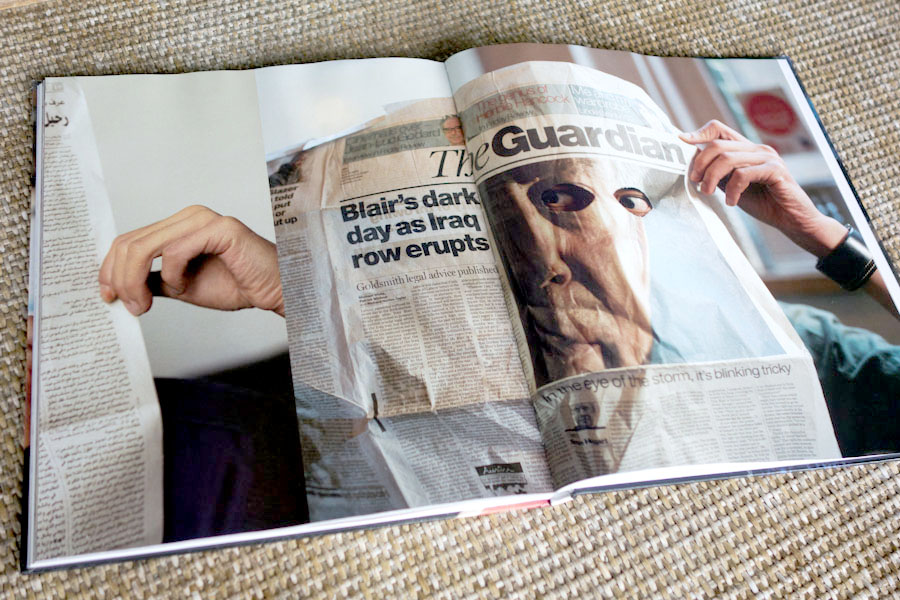
Earthling, is a satire of spectacle. It makes mincemeat of the torrent of information and imagery that we consume (and that consumes us). It reconfigures global media subjectivities. It resists. It reprograms. It ruffles my casual disregard for the everyday onslaught of the headline.
The book is about the size of a National Enquirer supermarket tabloid and is just as juicy—a banquet of full-bleed spreads. Fronted by a ruminative short essay by Barry Schwabsky and a lovingly casual but sharp-as-a-tack interview between Neidich and Hans Ulrich Obrist, the book is throughout illustrated by several installation shots of Neidich’s previous work and drawings.
The photographs are real-life representations of his particular perspective on media and consumption. Each photo is a rich, somewhat high-contrast, colorful composition of someone reading in a café, obscured by their respective newspaper or magazine: National Enquirer, International Herald Tribune, Interview, The Guardian, Newsweek, Daily Mirror. Roughly-cut holes in what they are reading reveal their eyes, looking out, sometimes up, sometimes over, and, most ominously, right at the camera.
Reviewed by Sarah Bay Williams
December 18, 2013
Equal Not Equal at LAXART (2015)




Duende Diagram at Mana Contemporary (2015)
"Duende Diagram" is a cartographic map of the different flows that constitute theories of a becoming cultured brain. Installation in "THEOREM: You Simply Destroy the Image I Always Had of Myself." Curated by Octavio Zaya.




Book Exchange: The Hollywood Blacklist

Book Exchange: The Hollywood Blacklist
January 30 – February 1, 2015
Printed Matter’s LA Art Book Fair 2015
“Book Exchange: Hollywood Blacklist” is a performative sculpture project whose mode of operation and purpose changes in each venue where it is displayed. For this occasion books authored and about Hollywood authors and actors suspected of being communists who were censored by the House Committee on Un-American Activities led by Joseph McCarthy were first bought off the internet and installed on the shelves of this rotating Modernist bookcase. During the fair visitors are asked to purchase a book from any vendor presenting with which to then make an exchange for one of the books found in the bookcase. It is hoped that by the end of the event all the books will have been distributed from the bookshelves to a heterogenous group of participants who will install them in bookshelves in their homes. Their act and participation refutes the essence of censorship which is to make unavailable to the general public certain forms of information. The bookshelf itself will contain the residue of the experience of the exchange as well as expressing the vast diversity of books being sold and exhibited at the fair.
Press
Los Angeles Art Book Fair 2015
in Flash Art by Noura Wedell
The Search Drive (2014)
[su_vimeo url="https://player.vimeo.com/video/103045578" width="1600"]
The Search Drive (2014) is a video work in which some of the same software programs utilized by the NSA to spy on Americans and foreign nationals, residing in America and abroad, are used by an autonomous agent to search through the web for personal and classified information about myself. Google, Facebook, Wikipedia, Instagram are hacked and ransacked. As such it traces over time an autobiographical sketch of my comings and goings, activities and friendships. I am calling this a Hack-ography. In the course of that analysis a number of things are revealed. One is my relationship with my assistant Ashiq Khondker, a 3rd Culture Bengali-Singaporean-American, whose actual activities are blurry but hypothetically link him to radical causes in Berlin and the Far East. In one image he is hanging out with Pussy Riot and in another wearing Egyptian robes. That I am a radical artists with anarchistic tendencies who has worked in Egypt with many Islamic musicians, as well as Franco Berardi the political activist, and have wired Ashiq money, creates a narrative of implied guilt by association to popular fears confusing Islam and Islamic fundamentalism. A fiction based on unconfirmed facts is thus built and now substitutes for any actual portrait I might actually have or had. A uncorroborated story of a fictitious life grows into a kind of monstrosity the result of a program gone haywire. This picture is full of flaws and leads to the necessity of my eradication. The need for courts of laws and warrants is not necessary. An algorithm is set in motion which brings together face and voice profiling systems and links it to a GPS location program. After my location has been determined, I am in fact in St. Petersburg, Russia performing an improvisational sound work called "NSA:USA Sound as Prophecy" which looks into whether Edward Snowden is a villain or hero, the drone program is set in motion to search and to eradicate my physical body leaving only my avatar soul to meander aimlessly in the networks of the virtual forever.
http://www.aqnb.com/2016/06/28/an-interview-with-warren-neidich/
Berlin Works: The Noologist’s Handbook and Other Art Experiments
Contributors: Suzana Milevska, Claudia Slaner, Julia Wirxel, John C. Welchman, Bruce Wexler, John Roberts, Franco “Bifo” Berardi
Archive Books, 2013
Download Catalog (low-res) 74Mb
This publication focuses on a series of recent projects of the Berlin-based American artist Warren Neidich, whose central preoccupation is, in fact, art research. More importantly, in focusing upon art practices that revolve around profound investigations of the complex reciprocal relation between contemporary theories of cognition, neuroplasticity, and art, on the one hand, and the emergence of new reciprocal relations between mind and creativity in the context of cognitive capitalism, semiocapitalism, and neurobiopolitics, on the other, Neidich’s research produces outcomes that challenge the very notions of the development of truth and knowledge.
Texts by Franco “Bifo” Berardi, John Roberts, Suzana Milevska, John C. Welchman, Bruce Wexler, and an interview with Warren Neidich by Claudia Slaner.
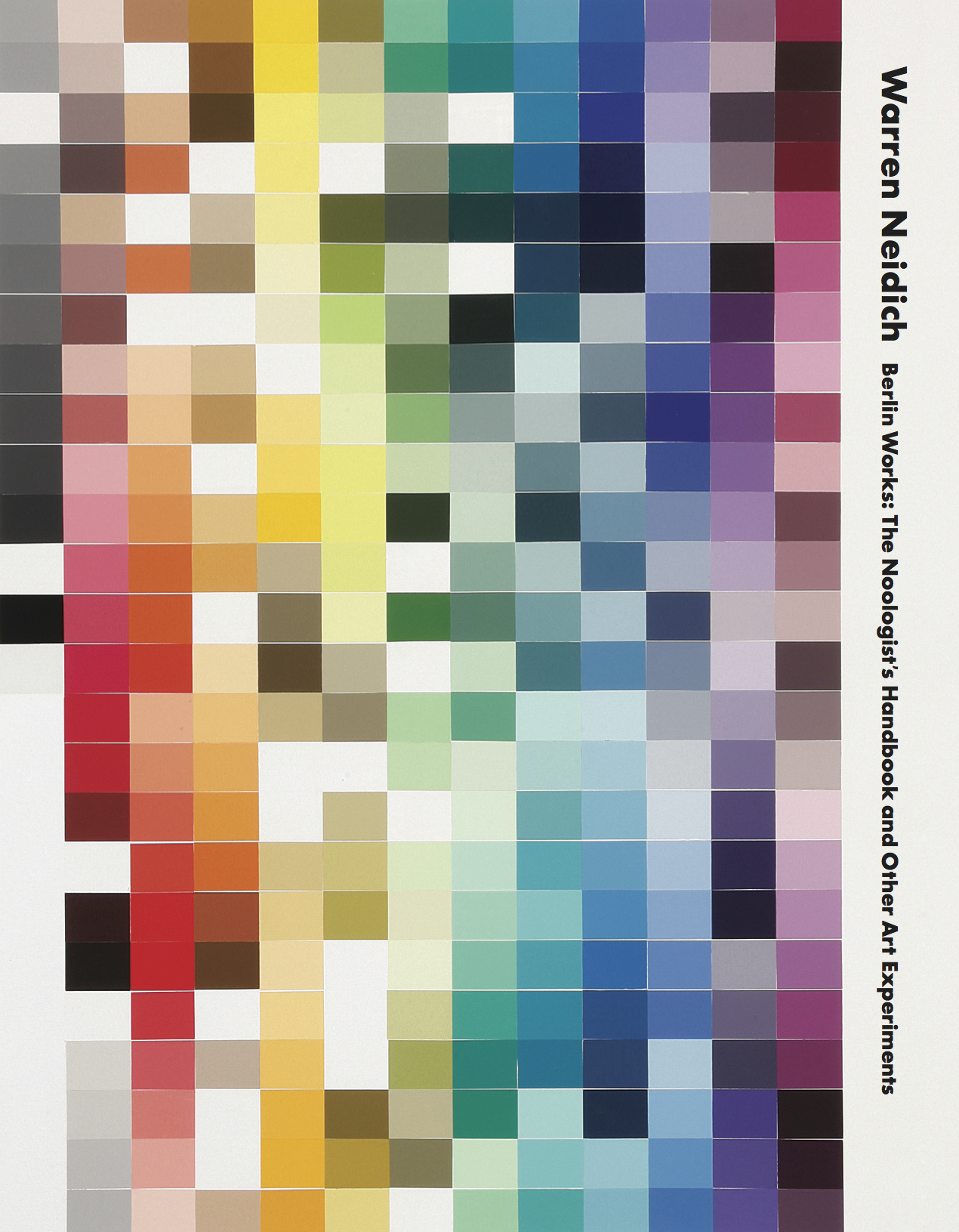
[su_spacer]
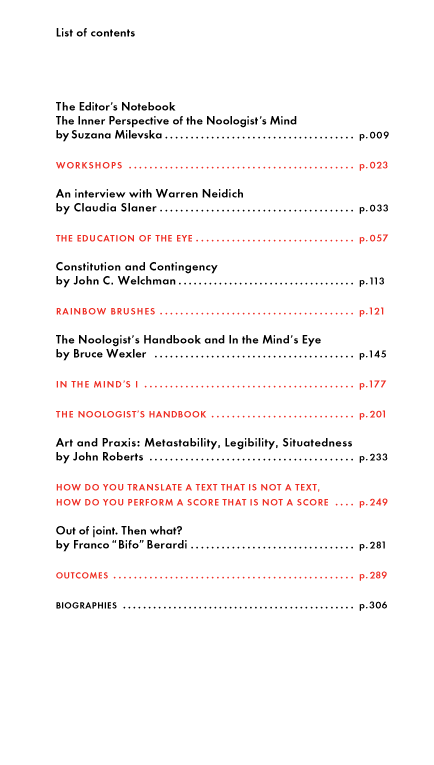
[su_spacer]
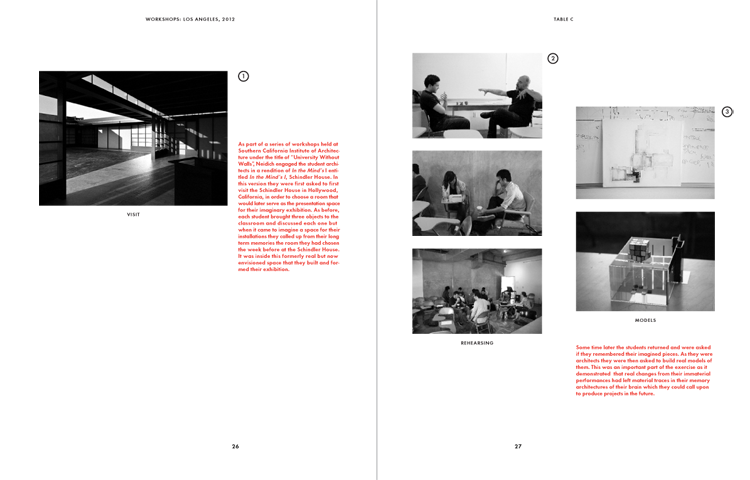
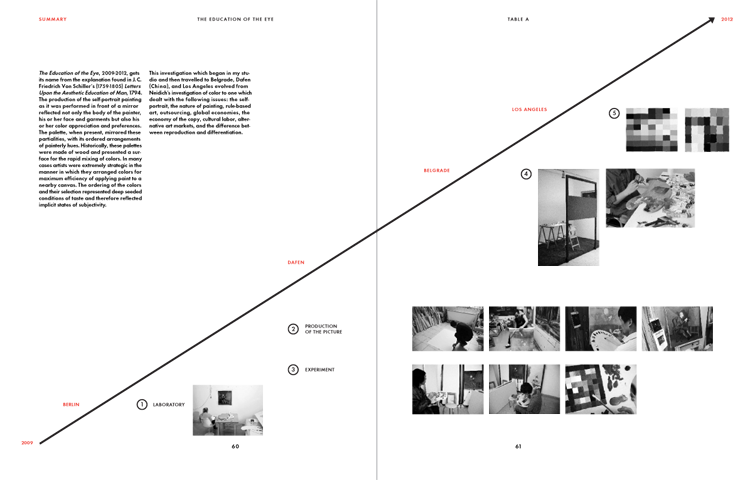

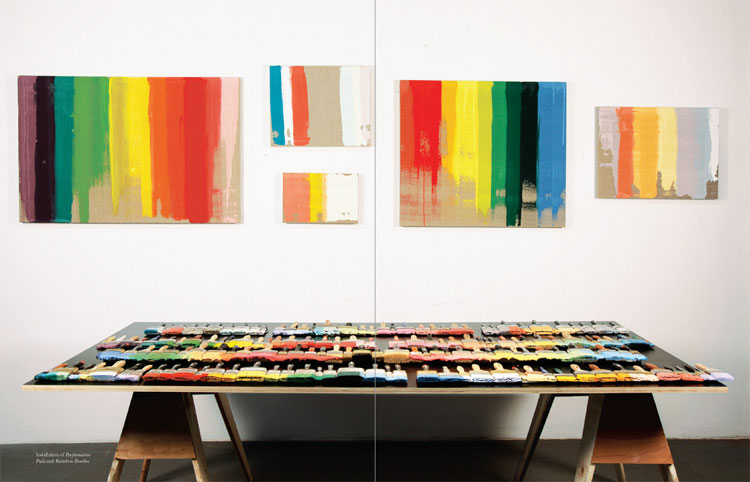


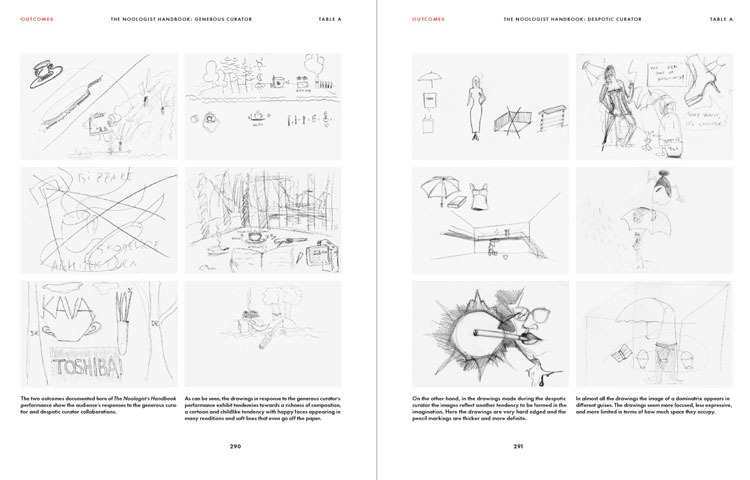
Wrong Rainbow Paintings, 2013–2014

Maurice Pendergrast, 1905 (after Rainbow), 2016
Acrylic paint on canvas with black velvet
130 × 160 cm
[su_spacer size="30"]

Frederic Edwin Church, 1866 (After Rainy Season in the Tropics), 2016
Acrylic paint on canvas with black velvet
130 × 160 cm
[su_spacer size="30"]

Caspar Friedrich 1810 (After Mountain Landscape with Rainbow), 2014
Acrylic paint on canvas with black velvet
130 × 160 cm
[su_spacer size="30"]

Joseph Anton Koch, 1815 (After Heroic Landscape With Rainbow), 2014
Acrylic paint on canvas with black velvet
130 × 160 cm
[su_spacer size="30"]

Wassily Kadinsky 1910-11 (After Cossacks), 2014
Acrylic paint on canvas with black velvet
130 × 160 cm
[su_spacer size="30"]

Peter Doik, 2014
Acrylic paint on canvas with black velvet
130 × 160 cm
[su_spacer size="30"]
INTERVIEW: SPOT Houston Center for Photography

Obrist: My first question to you is about this complex new kind of work called Earthling, that has to do with collage and also with the cultural field. Can you tell me about this?
Neidich: I have been working quite a lot with the history of apparatuses and technologies as they intervene in photography and new media. The history of photography, cinema, and new media is a history of the production and reinvention of time and space. These new forms of temporarily and spatiality become imbedded in architecture, fashion, design, and aesthetic practice and, as such, create new kinds of network relations, for instance in the visual-cultural field. These new networks relations in the real world, which might be called the real-imaginary-virtual interface, can configure neural networks in the brain. These networks are dynamic and as they reconfigure the matter of the brain, they produce new possibilities for the imagination and creativity. They allow the mind to become perceptual in a very different way. This latest work deals with, what I call, the “Earthling” and looks the “construction of global subjectivities” formed through the apparatus of global media.
Where does the name come from?
The name came from two sources, though this work is about of other things as well. The first is science-fiction movies, where a visitor from another planet addresses those who have come to meet him or her as “Earthlings.” The second is Sun Ra’s sci-fi-blaxploitation-jazz film, Space Is The Place, in which Sun Ra and the Intergalactic Solar Arkestra descend on forties’ Chicago from Saturn to enlighten “Earthlings” about an alternative planet built on good vibrations. I am also very much attracted to magazine culture, which is a kind of distributed information system. you can go through these magazines and DJ or VJ them; you can chose them, post-produce them, edit them.
What is you relation to them? Do you collect them or do you buy them everyday? you have something of an archive, though I’m not exactly what you’d call it. You deal so much with information. Do you have an archive for processing, for testing everyday information? Do you have a kind of art lab?
I do have a kind of art lab. This project started in a very different way and then it changed midway. It began with going to cafes, as all these pictures take place in cafes.
And you were recording in cafes?
Yes, I was very interested in this idea of indeterminate spaces, spaces where people kind of linger and then move on. Tourists always go to cafes, the bohemian culture started in cafes, and I wanted to connect with that. In the beginning of this series I started using whatever magazine I found at the cafe as a readymade or found object. It operated as a kind of fetish of the cafe. Then, as the project progressed, I became more interested in magazines in general. It was then that I started collecting them. The project started about two years ago, and about a year ago I started realizing that I was missing some of the great headlines: this one about Tony Blair in the Morning Star, for instance, concerns the idea of the delusion. I didn’t find that one in a cafe. I saw it on a newsstand and realized that I really wanted to utilize all the information available and not restrict myself to a certain set of rules or regulations.
I think that artists have to put some regulations on the projects they do, otherwise they become unfocused. In this case, I changed the rules and started collecting the magazines from anywhere and anyplace. A lot of different things started happening when I made that decision, and that is when I really got into the language of magazines. How funny they can be. How funny certain juxtapositions of headlines, titles, and advertisements can be, like Surrealist/Situationist jokes. I became interested in how headlines were use in different ways, in the multiple layers of textuality, and how they relate to different kinds of temporality. For instance, the headline is something like a sound bite. It has a very quick temporality. Then you have the subtitles, which are read in a different amount of time. You can read the newspaper in different temporal zones and you can utilize different methodologies to access the information. You can read each article through and through and in a serial way, moving from one article to another, or you can read it randomly like a dérive.
What interests me is that you are always bridging to other disciplines: you have a great and interesting connection to science and architecture. Can you tell me a little bit more about how you came into this contact zone, about how it started?
Well, I have always been interested in history and critical theory. I have believed from the beginning that art should produce new sensations, new kinds of perceptions, new kinds of imaginings.
Like Felix Gonzalez-Torres’ art produces extraordinary experiences?
Or hallucinatory experience. Let’s go beyond that. Art is a kind of exercise for the possibilities of the mind. It’s like break-dancing or ballet.
Like a non-chemical LSD?
Yes, like a non-chemical LSD. That could get me into my theory called the “Society of Neurons,” which is a different question and one I’m not sure I want to trip into right now. But since you asked, here is a little of that theory. Different kinds of artistic experience stimulate or call out to different populations of neurons which produce signals utilizing different neurochemistries, like dopamine, acetylcholine, etc. In some cases, artists take specific drugs, like peyote, as part of the rituals surrounding their art production. Ecstasy, an exhibition currently going on at the Museum of Contemporary Art, Los Angeles, addresses this very issue that the experience and the consciousness it facilitates is the product of what I am referring to as “Society of Neurons” and how they all act in harmony at any moment of awareness. They express themselves differentially depending on context in a ratiomatic manner. The ontogency, or individual development, of the nervous system and the subject may be a result of a coevolutionary process by which certain kinds of cultural context call out to the developing nervous system differentially and favor the selection of certain kinds of cultural context call out to the developing nervous system differentially and favor the selection of certain neurochemical systems over others. Each culture may provide a stable enough network or symbolic ecology, which has evolved over thousands of years and which produces individual subjectivities generation over generation through sculpting networks of neurons, spatially and dynamically, preferentially. Art affects visual, auditory, and haptic culture. Art, like cinema, accordingly to Deleuze, may create new forms of connectivity possibly affecting the distribution of neurochemical systems in the brain. This theory gives a powerful new important to art.
My ideas about art and the brain are not intended to illustrate concepts and ideas of neuroscience, which can be a problem for art-science initiatives. They are about importing a new vocabulary that artists can fold into their art practice, as a way of energizing it through the production of difference and hybridity. If anything, my work is not about perception of sensation but rather about evolution and ontogeny. Artists like Seurat, Duchamp. Cézanne, the Futurists, Richard Hamilton, Bridget Riley, Gary Hill, and Dan Graham were all interested in science. Olafur Eliasson, Matthew Ritchie, and Carsten Holler are artists today who also share this interest. I once talked to Dan Graham about the early seventies and he told me that all the artists were reading electronics and science magazines. What I am trying to say is that many artists have folded concerns with science almost imperceptibly into larger networks of culture, sociology, psychology, economics, and history to produce a Gesamtkunstwerk.
Marina Abramovich’s interest in Tessler and so on…
Yes, absolutely. Artists have always worked that way. It’s also interesting what happened post 1992/1993, after the internet explosion. What happened was that all the barriers, all the specificity of materials, started breaking down. Whether you are talking about art or you are talking about the barriers between different knowledge fields like science, cultural theory, or critical theory, they all started breaking down.
Has the internet changed the way you work?
I already had a history of being a scientist, having studied neurosciences and been a doctor in the eighties. After completing a project called Camp O.J, where I photographed the press at the O.J. Simpson trial as one would a rock-and-roll concert for Spin Magazine. I felt that I had nothing more to say about the relation of the production and mediation of the real using the theoretical tools that make up the toolbox of art. I realized that it was time to embrace my past as a scientist in order to inject a new vocabulary into my work, as well as perhaps to discover the neurobiological roots of what I was observing in the macrocultural field. Perhaps I felt the need to reinvent myself as well. Perhaps political and social systems were operating at the level of the neuron network, and biopolitical through, as in the “Society of Control” outlined by Foucault, was being directed toward the brain. The Earthling series and a recent text I wrote for a forthcoming book edited by Deborah Hauptmann called The Body in Architecture and my essay therein is called “Resistance is Futile: The Neurobiopolitics of Consciousness” are to some extent the culmination of this project…
Have you ever thought about memory in your work, because memory has always been considered static, whereas in actuality it is a dynamic process?
I have done a number of projects concerning different aspects of memory. Artists have always embraced memory and one could say there was an aesthetic memory. For instance, Christian Boltanski and Annette Messanger have explored cultural memory and traumatic memory for some time now. American History Reinvented (1986-1991), Collective Memory-Collective Amnesia (1990-1994) and Beyond the Vanishing Point: Media and Myth in America (1996-2001) were three projects I did in which memory was a preponderant interest. The Earthling project riffs off these and concerns the construction of a global memory in the sense of what Paul Virilio called “phaticity.” The word phatic is the root of the word emphatic. The history of the image, coevolving with that of the imagination, is one in which images are being produced that are more and more attention-grabbing, more phatic. These images are in competition with each other in the visual-cultural field, and over time they are becoming more refined, or what I call cognitively ergonomic-the images that most successful in drawing the attention of the observer are the ones that take advantage of the dynamic ontogenic proclivities of the nervous system. What I mean is that the static condition of photography has been superseded by the linear dynamic time of cinema, which has been remediated by the non-linear digital time and space of new media (non-narrative cinema is a transitional phase). The addition of dynamic aspects has made images more and more phatic, more and more cognitively ergonomic. This refinement is the product of the image-industry, of collusion between advertising, cinematic special-effects, and now the political propaganda machine. …
In your work you use photography, video, sculpture, installation, and drawing, even the reinvention of photography. If you look at the work of Ed Ruscha you could say that the car is his medium. What is your medium?
What is my medium? Well, I started as a photographer. By the way, Rirkrit Tiravanija started as a photographer too, I don’t know if you knew that.
He wanted to become a documentary photographer like a Magnum photographer.
Well, in answer to your question, if Ruscha’s medium is his car mine might be the brain. I mean that as a joke. Anyway, what is very important to understand about my work is that since I began as a photography I tend to think of all mediums in terms of photography. For instance, in London I did this project called Blindsight in which I used the machine they paint streets with to paint a green line from the subway station to Moorfields Eye Hospital, so that partially sighted people could find their way there. It was a kind of Situationist project about nested perceptual realities within the larger framework of the urbanscape. In the end, however, the line became something that I photographed and that generated images. Beyond the photographs of the document of my performance I actually made images that recounted the very nature of what it is to be blind and described the limits of the camera as image machine. Could the camera act like touch and construct a total image from a multiplicity of possible focal points in time, in memory?
I did another work called Silent in Madrid. My partner, Elena Bajo, and I bought something that’s usually installed in suburban communities-a highway sound barrier- into the center of Madrid. It was a 70m sculpture that created a space of solitude and mediation in the middle of the city. For me, it ended up as something to photograph. It was reminiscent of a large earth work like Spiral Jetty, which became known more as a series of documentary images. I mention this because I am still very much a photography. No matter what I do, it always comes down to the static image of the photograph or the video. The difference between myself and Nan Goldin, and what make me very close to somebody like Thomas Ruff, it is that I am not so much interested in the image. I am not a photographer that explored the image and tried to construct a specific style: i am more interested in artists who use different mediums within photography itself. I used many kinds of historical processes in American History Reinvented, from Platinum to albumen prints. In the O.J. Simpson and Beyond the Vanishing Point projects I cross-processed the photographs. I am much more about mediums than actual images, although I do think there is always a perfect process for a particular group of images. I am also about apparatus. Like Jean-Luc Godard, I use different apparatuses. I am interested in how an image is produced. I am making the production of the image transparent. I am not interested in dislocating the viewer from how the image was made, but want him or her to feel part of the process. In Godard’s Mépris, for instance, the first scene opens with a man holding the microphone for the actress and the next scene is simply the camera lens. In the middle of the film Godard stops the action and interviews himself.
It’s very much like Lars Von Trier, but in an interesting way he creates a different situation.
Lars Von Trier is very much like Godard in that he dispenses with all the high-tech paraphernalia of cinematic production, leaving you with the grain of the film, poor lighting, and camera movement. So, by complete denial, you affirm what is it you want to relinquish. As I said, everything is Godard.
Everything is Godard.
Yes, everything is Godard. If you look at what many artists are doing today, so much is influenced by him.
I think that is a great conclusion. Thank you.
Warren Neidich is currently a visiting art and research fellow at the Center for Cognition, Computation and Culture at Goldsmiths College, London.
Hans Ulrich Obrist is co-director of the Serpentine Gallery, London and curator at the Museum of Modern Art Ville de Paris, France. He curated “Utopia Station” at the 2003 Venice Biennial.











